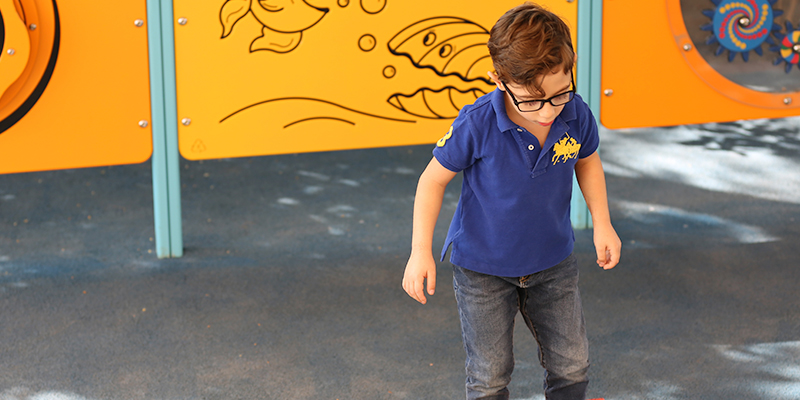

Ataxia: The disorder of thinking and doing

Kunali Doshi
DHA License Number: 00100771-002
Senior Pediatric Physical Therapist

Neurologist Dr Patricia Hartlage defines ataxia as the condition of being unable to get a taxi: When arriving at an airport, one usually hails a taxi to take a direct route to the hotel. However, when a taxi is unavailable, one uses a bus, limo, or a train to reach the destination after stopping by many other places.
Introduction
Ataxia is a common childhood movement disorder, with an estimated worldwide prevalence of 26/100,000 for both genetic and acquired causes.
Childhood ataxias may be acquired (e.g., following stroke, traumatic brain injury (TBI), cerebral palsy (CP), or cerebellar tumor), inherited (e.g., spino-cerebellar ataxia (SCA), Friedreich’s ataxia (FRA)) or idiopathic ataxia).
In the absence of effective pharmacological options, rehabilitation―particularly physical therapy―remains the mainstay of treatment.
Sensory-motor presentation
Children with ataxia present with typical movement patterns; however, they exhibit atypical ordering, sequencing, and timing. Their body seems more symmetrical with diminished trunk rotations or movements outside their base of support. These children often appear to be intrusive, stubborn, chaotic, and are often considered as misbehaved children. They are slow processers and may be diagnosed with learning disabilities, autism, or attention deficit disorder.
Meaning of ataxia and its origin
Ataxia is a disturbance in the coordination of movement, leading to difficulties with fine tuning of movements and posture. This movement incoordination can sometimes be confused with muscle weakness.
Coordination of movement comes from the cerebellum, which is normally capable of analyzing movements as we do them; it compensates for errors by comparing intention with performance. It refines the movement as it is produced.
Cerebellum
The little brain, as the cerebellum is called, is that part of the brain that tells us: first let us do THIS and then do THAT e.g., first put on socks and then shoes. It is responsible for refinement and fine tuning of movements while also contributing to our five senses as well as pain, movements, thought, and emotion.
The cerebellum sits under the cortex and processes vestibular and proprioceptive input and is an interpretation checkpoint for all sensations. Working with children through the sensory systems will help soothe their emotional pathways, bolstering their tolerance for anxiety, stress, and emotional dysregulation.
The root cause of disruption and imbalance in motor behavior comes from the sensory system. Cerebellar challenges result in poor coordination, slowed thinking and speech, disorganization, poor impulse control, and learning difficulties.
Ataxia symptoms
The principal symptom of ataxia is a disturbance of balance and equilibrium, a particular kind of unsteadiness in which patterns of movement are normal per se, but which are not adjusted to the outside world.
Although the site of lesion responsible for ataxia is the cerebellum, many adjoining areas of the brain in close connection to the cerebellum may be involved, leading to presentation similarities like autism.
Most children who finally receive a diagnosis of ataxia present initially with mild hypotonia (low tone). In the early years, spasticity or dyskinesia could co-exist with ataxia and mask the subtle issues related to ataxia. Tremoring occurs rarely in children below the age of 3 years and could be completely absent, even in the most severe forms of ataxia.
How do children with ataxia function?
Motor deficits
Mothers typically report that the infants achieve the more static milestones like sitting, all fours, or standing at a close to average age. However, children find it difficult to move in between positions in the form of transitional movements. It is observed that the child does not roll, assume sit, pull to stand, or walk independently.
Gross motor tasks of sitting, standing, and stepping are performed with a wider base of support with the limbs far apart to increase stability.
They resist weight shifts and stiffen up throughout their body rather than one single limb.
The general tendency of the trunk is to be fixed in a rounded posture with limited rotations.
Children with ataxia prefer to keep their joints in a locked position in end range to provide postural stability. This helps them to stabilize their body from inability to stabilize using muscle force.
They demonstrate difficulty in grading the force generation and stiffness in the muscles to match the tasks. They often tend to experience fatigue after physical activity due to over expenditure of energy to generate force. You may hear some children slap their feet on the ground whilst walking. They often tend to bump into people or surfaces due to lack of knowledge of when to stop.
Truncal tremors, fine intention tremors, and/or nystagmus of the eyes are observed most often after the age of 2-3 years.
Sensory deficits
Children with ataxia present with clear sensory losses, which may be more significant than motor deficits.
Decreased proprioceptive awareness which is evident due to the lack of awareness to imitate limb or body postures. They demonstrate past pointing, over shooting or under shooting when reaching for objects.
Inconsistency of response to discrimination of tactile input due to which the child may be poorly labelled as having a behavior disorder. This is present all over the body including the oro-motor areas, which makes them messy eaters. Children may gobble an entire sandwich and stuff their mouth with food.
The child prefers to visually fix at a point for postural stability and is evident when the child is higher up and moving against gravity. These kids will fix their gaze at one point in the distance and walk towards it using tunnel vision, and lack awareness of the ambience or environment around them.
There is frequently an increased latency between sensory stimulus and response; for example, responding to question after a long pause.
Communication
Communication is often significantly limited, and children have a flatter affect with limited nonverbal expressions and gestures.
The children do not usually make eye contact while communicating. Their responses to voices and auditory information is delayed, which can give the impression of poor cognition.
Due to lack of oro-motor awareness, articulation is poor and down to few word utterances rather than to a full and complex sentence. Speech is slow and slurred.
Strategies to improve balance and coordination
- Use of tactile, visual, and proprioceptive cues to improve motor performance;
- Task is broken down into smaller components for practice;
- Use of repetition to achieve motor performance;
- Use of weighted belts, and resistance training to improve body awareness;
- Wearing lycra garments, Dynamic Movement Orthoses can aid in improving central tone;
- Strengthening trunk muscles to improve dynamic balance and coordination;
- Hydrotherapy can assist in overcoming inertia with improved posture and balance;
- Providing an interactive environment that requires limb movement to react to on-screen games (e.g., Wii, Xbox), may also be included as part of a physical therapy training program; and,
- Task-specific training with the aim of acquiring a motor skill; exercises that focus on regaining or sustaining control of the proximal muscles of the trunk, shoulder, and pelvic girdle.
Sources:
- Neuro-Developmental Treatment-A Guide to NDT Clinical Practice, Cerebral Palsy Marcia Stamer, PT, MH, C/NDT, 2016.
- Neuro-Developmental Treatment- A Guide to NDT Clinical Practice, Principles and Process of NDT Intervention, Howle (2004).
- https://ijponline.biomedcentral.com/articles/10.1186/s13052-016-0325-9.


